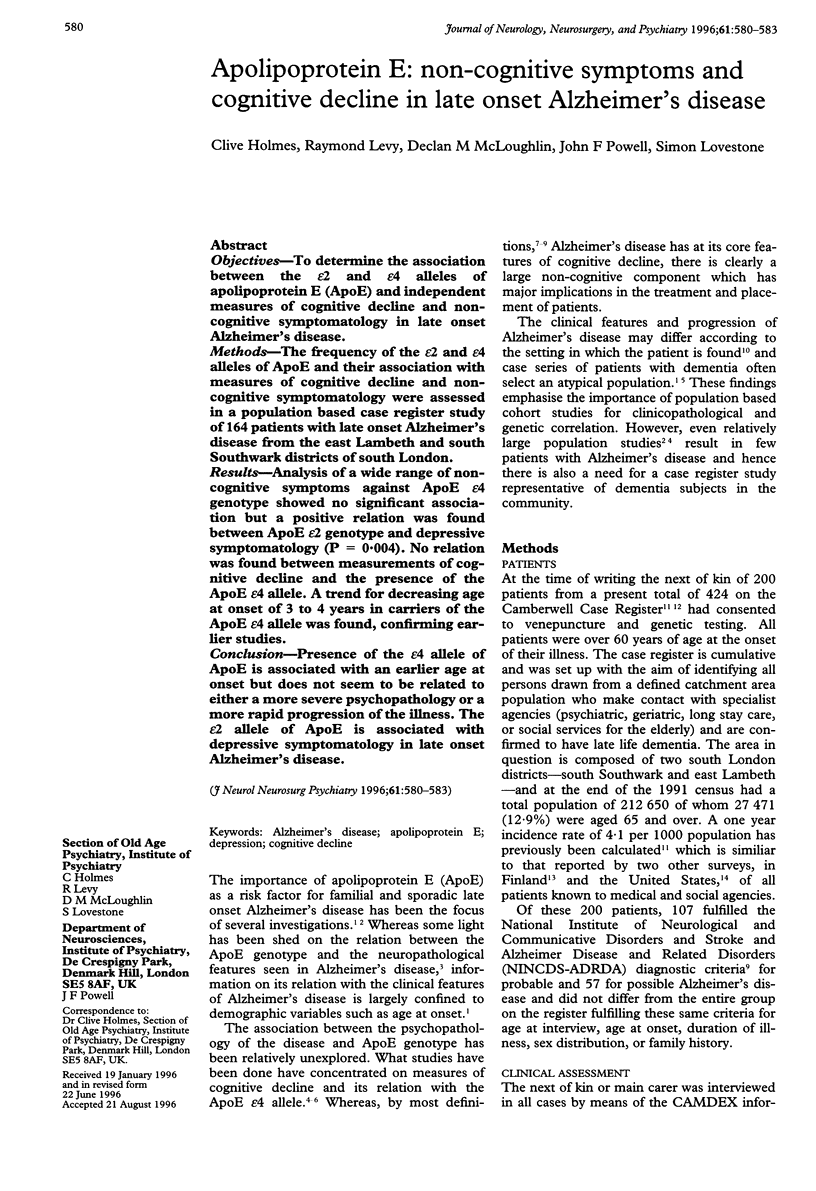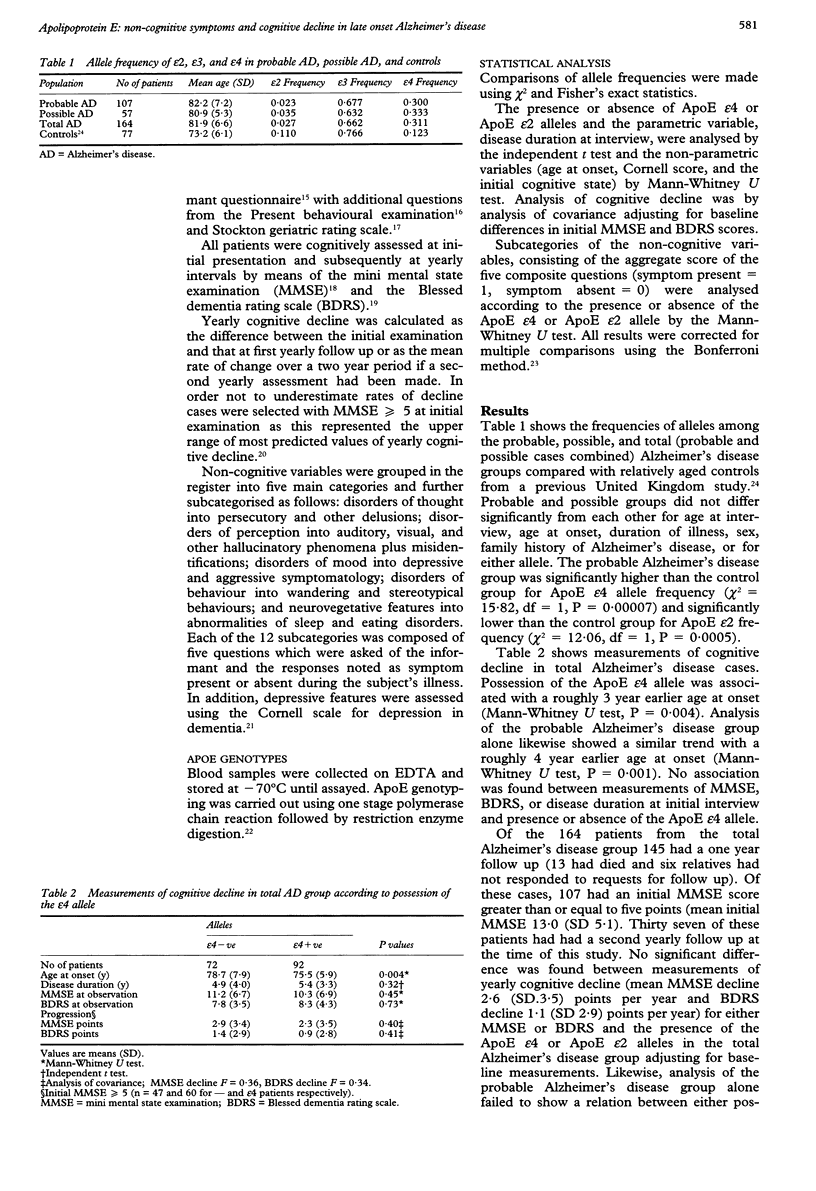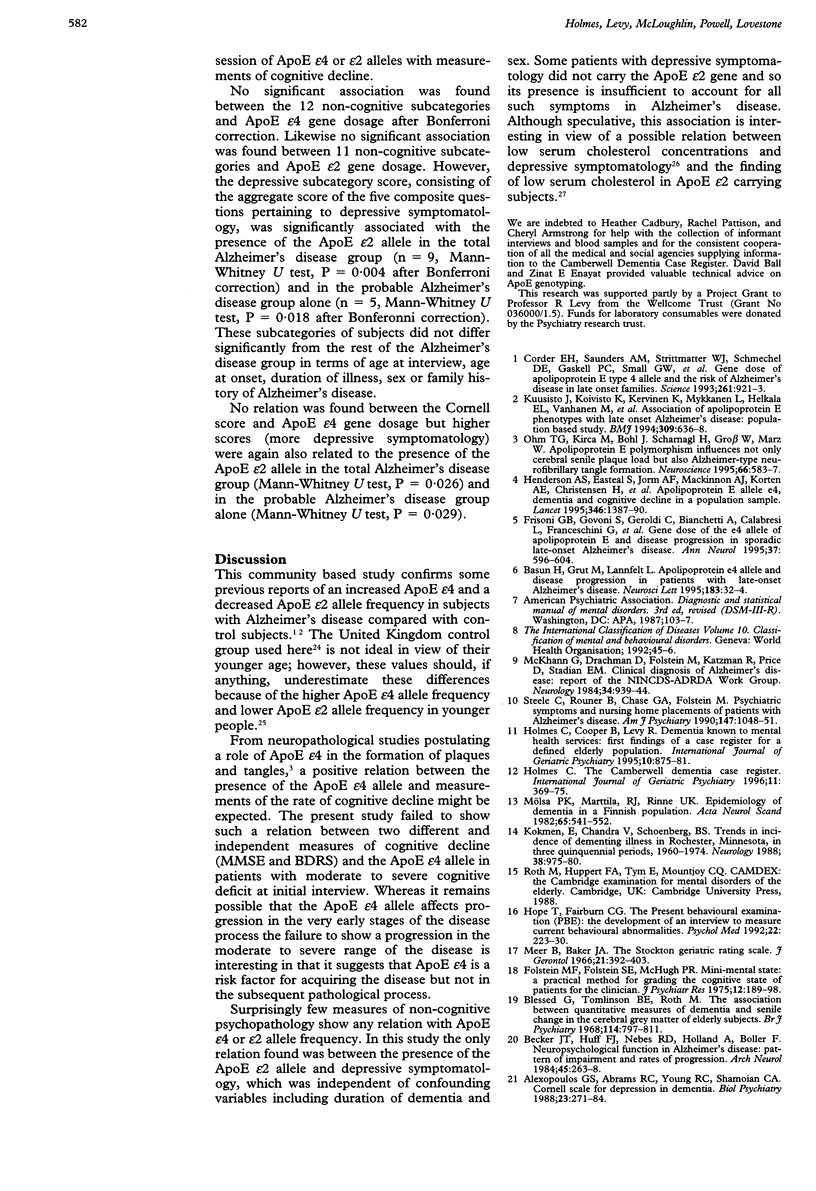Abstract
OBJECTIVES: To determine the association between the epsilon2 and epsilon4 alleles of apolipoprotein E (ApoE) and independent measures of cognitive decline and non-cognitive symptomatology in late onset Alzheimer's disease. METHODS: The frequency of the epsilon2 and epsilon4 alleles of ApoE and their association with measures of cognitive decline and non-cognitive symptomatology were assessed in a population based case register study of 164 patients with late onset Alzheimer's disease from the east Lambeth and south Southwark districts of south London. RESULTS: Analysis of a wide range of non-cognitive symptoms against ApoE epsilon4 genotype showed no significant association but a positive relation was found between ApoE epsilon2 genotype and depressive symptomatology (P = 0.004). No relation was found between measurements of cognitive decline and the presence of the ApoE epsilon4 allele. A trend for decreasing age at onset of 3 to 4 years in carriers of the ApoE epsilon4 allele was found, confirming earlier studies. CONCLUSION: Presence of the epsilon4 allele of ApoE is associated with an earlier age at onset but does not seem to be related to either a more severe psychopathology or a more rapid progression of the illness. The epsilon2 allele of ApoE is associated with depressive symptomatology in late onset Alzheimer's disease.
Full text
PDF



Selected References
These references are in PubMed. This may not be the complete list of references from this article.
- Alexopoulos G. S., Abrams R. C., Young R. C., Shamoian C. A. Cornell Scale for Depression in Dementia. Biol Psychiatry. 1988 Feb 1;23(3):271–284. doi: 10.1016/0006-3223(88)90038-8. [DOI] [PubMed] [Google Scholar]
- Basun H., Grut M., Winblad B., Lannfelt L. Apolipoprotein epsilon 4 allele and disease progression in patients with late-onset Alzheimer's disease. Neurosci Lett. 1995 Jan 2;183(1-2):32–34. doi: 10.1016/0304-3940(94)11107-t. [DOI] [PubMed] [Google Scholar]
- Becker J. T., Huff F. J., Nebes R. D., Holland A., Boller F. Neuropsychological function in Alzheimer's disease. Pattern of impairment and rates of progression. Arch Neurol. 1988 Mar;45(3):263–268. doi: 10.1001/archneur.1988.00520270037018. [DOI] [PubMed] [Google Scholar]
- Blessed G., Tomlinson B. E., Roth M. The association between quantitative measures of dementia and of senile change in the cerebral grey matter of elderly subjects. Br J Psychiatry. 1968 Jul;114(512):797–811. doi: 10.1192/bjp.114.512.797. [DOI] [PubMed] [Google Scholar]
- Corder E. H., Saunders A. M., Strittmatter W. J., Schmechel D. E., Gaskell P. C., Small G. W., Roses A. D., Haines J. L., Pericak-Vance M. A. Gene dose of apolipoprotein E type 4 allele and the risk of Alzheimer's disease in late onset families. Science. 1993 Aug 13;261(5123):921–923. doi: 10.1126/science.8346443. [DOI] [PubMed] [Google Scholar]
- Folstein M. F., Folstein S. E., McHugh P. R. "Mini-mental state". A practical method for grading the cognitive state of patients for the clinician. J Psychiatr Res. 1975 Nov;12(3):189–198. doi: 10.1016/0022-3956(75)90026-6. [DOI] [PubMed] [Google Scholar]
- Frisoni G. B., Govoni S., Geroldi C., Bianchetti A., Calabresi L., Franceschini G., Trabucchi M. Gene dose of the epsilon 4 allele of apolipoprotein E and disease progression in sporadic late-onset Alzheimer's disease. Ann Neurol. 1995 May;37(5):596–604. doi: 10.1002/ana.410370509. [DOI] [PubMed] [Google Scholar]
- Henderson A. S., Easteal S., Jorm A. F., Mackinnon A. J., Korten A. E., Christensen H., Croft L., Jacomb P. A. Apolipoprotein E allele epsilon 4, dementia, and cognitive decline in a population sample. Lancet. 1995 Nov 25;346(8987):1387–1390. doi: 10.1016/s0140-6736(95)92405-1. [DOI] [PubMed] [Google Scholar]
- Hope T., Fairburn C. G. The Present Behavioural Examination (PBE): the development of an interview to measure current behavioural abnormalities. Psychol Med. 1992 Feb;22(1):223–230. doi: 10.1017/s0033291700032888. [DOI] [PubMed] [Google Scholar]
- Kokmen E., Chandra V., Schoenberg B. S. Trends in incidence of dementing illness in Rochester, Minnesota, in three quinquennial periods, 1960-1974. Neurology. 1988 Jun;38(6):975–980. doi: 10.1212/wnl.38.6.975. [DOI] [PubMed] [Google Scholar]
- Kuusisto J., Koivisto K., Kervinen K., Mykkänen L., Helkala E. L., Vanhanen M., Hänninen T., Pyörälä K., Kesäniemi Y. A., Riekkinen P. Association of apolipoprotein E phenotypes with late onset Alzheimer's disease: population based study. BMJ. 1994 Sep 10;309(6955):636–638. doi: 10.1136/bmj.309.6955.636. [DOI] [PMC free article] [PubMed] [Google Scholar]
- Liddell M., Williams J., Bayer A., Kaiser F., Owen M. Confirmation of association between the e4 allele of apolipoprotein E and Alzheimer's disease. J Med Genet. 1994 Mar;31(3):197–200. doi: 10.1136/jmg.31.3.197. [DOI] [PMC free article] [PubMed] [Google Scholar]
- McKhann G., Drachman D., Folstein M., Katzman R., Price D., Stadlan E. M. Clinical diagnosis of Alzheimer's disease: report of the NINCDS-ADRDA Work Group under the auspices of Department of Health and Human Services Task Force on Alzheimer's Disease. Neurology. 1984 Jul;34(7):939–944. doi: 10.1212/wnl.34.7.939. [DOI] [PubMed] [Google Scholar]
- Meer B., Baker J. A. The Stockton Geriatric Rating Scale. J Gerontol. 1966 Jul;21(3):392–403. doi: 10.1093/geronj/21.3.392. [DOI] [PubMed] [Google Scholar]
- Morgan R. E., Palinkas L. A., Barrett-Connor E. L., Wingard D. L. Plasma cholesterol and depressive symptoms in older men. Lancet. 1993 Jan 9;341(8837):75–79. doi: 10.1016/0140-6736(93)92556-9. [DOI] [PubMed] [Google Scholar]
- Mölsä P. K., Marttila R. J., Rinne U. K. Epidemiology of dementia in a Finnish population. Acta Neurol Scand. 1982 Jun;65(6):541–552. doi: 10.1111/j.1600-0404.1982.tb03109.x. [DOI] [PubMed] [Google Scholar]
- Mölsä P. K., Marttila R. J., Rinne U. K. Epidemiology of dementia in a Finnish population. Acta Neurol Scand. 1982 Jun;65(6):541–552. doi: 10.1111/j.1600-0404.1982.tb03109.x. [DOI] [PubMed] [Google Scholar]
- Ohm T. G., Kirca M., Bohl J., Scharnagl H., Gross W., März W. Apolipoprotein E polymorphism influences not only cerebral senile plaque load but also Alzheimer-type neurofibrillary tangle formation. Neuroscience. 1995 Jun;66(3):583–587. doi: 10.1016/0306-4522(94)00596-w. [DOI] [PubMed] [Google Scholar]
- Schächter F., Faure-Delanef L., Guénot F., Rouger H., Froguel P., Lesueur-Ginot L., Cohen D. Genetic associations with human longevity at the APOE and ACE loci. Nat Genet. 1994 Jan;6(1):29–32. doi: 10.1038/ng0194-29. [DOI] [PubMed] [Google Scholar]
- Utermann G., Hees M., Steinmetz A. Polymorphism of apolipoprotein E and occurrence of dysbetalipoproteinaemia in man. Nature. 1977 Oct 13;269(5629):604–607. doi: 10.1038/269604a0. [DOI] [PubMed] [Google Scholar]
- Wenham P. R., Price W. H., Blandell G. Apolipoprotein E genotyping by one-stage PCR. Lancet. 1991 May 11;337(8750):1158–1159. doi: 10.1016/0140-6736(91)92823-k. [DOI] [PubMed] [Google Scholar]


